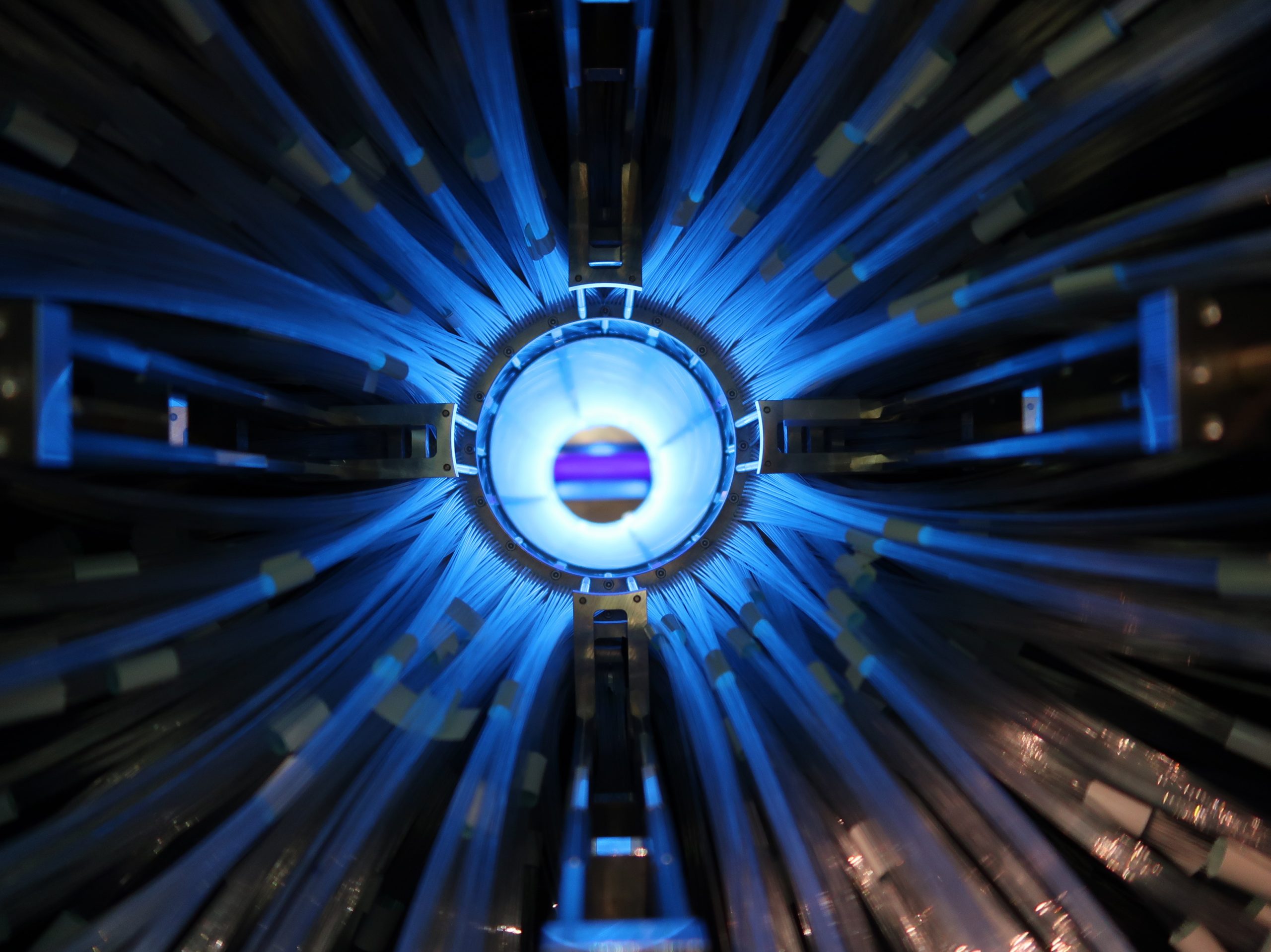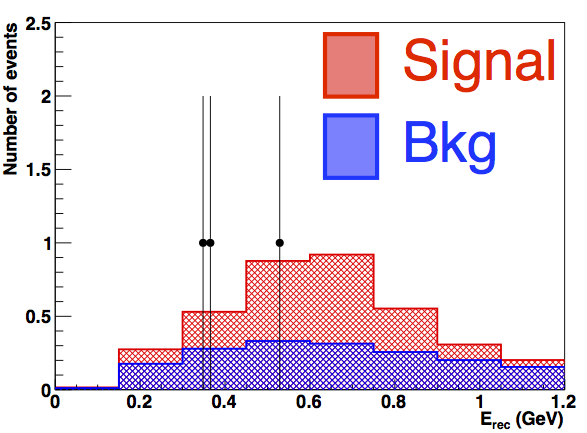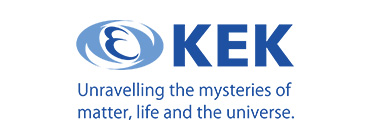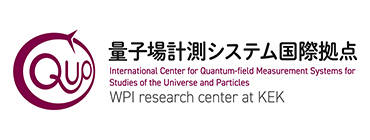- Topics
First look at antineutrino appearance from T2K
July 24th, 2015
The T2K (Tokai-to-Kamioka) experiment in Japan has observed three electron antineutrino candidate events in a muon antineutrino beam. T2K creates and monitors a muon antineutrino beam at the J-PARC facility in Tokai village on the east coast of Japan, and sends it 295 km west to the Super-Kamiokande detector underneath Mt. Ikeno near Toyama, which was built, and is operated, by ICRR. This is the first antineutrino appearance search by the collaboration, which also observed muon antineutrino disappearance earlier this year. The appearance and disappearance of neutrino and antineutrinos flavours is called neutrino oscillation and occurs because of the quantum mechanical interference of neutrino masses and flavours. [About Neutrinos]
T2K began collecting data in antineutrino mode in May 2014, and completed its first run in antineutrino mode in June 2015, collecting 10% of their expected antineutrino data set. Before this run, T2K took data in neutrino mode, 2010–2013, and definitively established electron neutrino appearance from a muon neutrino beam. Based on their neutrino mode results, T2K would expect to observe 3.8 events, with 1.8 coming from backgrounds. Although three events is too small to draw firm conclusions, it is a first for T2K with antineutrinos.
“These events are a clear demonstration of the potential of the T2K experiment to perform a powerful antineutrino oscillation search,” reported Kyoto University Professor Tsuyoshi Nakaya, Spokesperson of the T2K collaboration. “We will run in antineutrino mode again in the autumn and we should collect more than twice the data we already have, which could give us enough data to make a significant observation.”
The search for electron antineutrinos is the next step in the exploration of charge-parity (CP) symmetry, which stipulates that antimatter should behave just like matter if viewed through a mirror and upside down. CP violation in neutrinos would manifest itself as antineutrinos oscillating differently than neutrinos, and if this happens it is a strong clue as to the origins of the matter/antimatter imbalance in the Universe today [CERN Courier].
“Our neutrino mode results gave a first hint that CP might be violated by neutrinos. If that is the case, then our electron antineutrino appearance rates will be suppressed. Our current statistics are not high enough to be sure. For that, we will need to continue running long enough to accumulate sufficient data for a large signal,” said Dr Morgan Wascko, Imperial College London, International Co-Spokesperson of T2K. “But we look forward to that challenge!”
Concurrent with the release of the electron antineutrino appearance result, T2K has also updated its observation of muon antineutrino disappearance. In this analysis, the collaboration expects to observe 103.6 events passing the muon antineutrino selection requirements, but instead observed just 34. This clear signature of antineutrino disappearance strengthens the collaboration’s already world-best measurement of the antineutrino mixing angle, θ23.
The T2K collaboration is a team of nearly 500 scientists from 59 institutes in Canada, France, Germany, Italy, Japan, Poland, Russia, Spain, Switzerland, the United Kingdom, and the United States. The result was announced at the European Physical Society Conference on High Energy Physics (EPS-HEP 2015) in Vienna on July 23, and was followed by seminars at KEK/J-PARC in Japan and Fermilab in the USA.
“This encouraging result relies on the hard work of the J-PARC Accelerator Division,” said Prof Nakaya.
More detailed information on this announcement including images, T2K experiment and T2K collaboration can be found from the T2K public webpage.
Contacts
Globally and in Japan
- Prof. Tsuyoshi Nakaya,
- Spokesperson, T2K Collaboration, Kyoto University,
- t.nakaya@scphys.kyoto-u.ac.jp
Globally and in UK
- Dr. Morgan Wascko,
- International Co-Spokesperson, T2K Collaboration, Imperial College London,
- m.wascko@imperial.ac.uk
In Canada
- Prof. Hiro Tanaka,
- University of British Columbia (Vancouver, Canada),
- tanaka@phas.ubc.ca
In France
- Dr. Marco Zito,
- CEA/IRFU (Saclay, France),
- marco.zito@cea.fr
In Germany
- Prof. Stefan Roth,
- RWTH Aachen University (Aachen, Germany),
- roth@physik.rwth-aachen.de
In Italy
- Dr. Maria Gabriella Catanesi,
- INFN Sezione di Bari (Bari, Italy),
- gabriella.catanesi@cern.ch
In Poland
- Prof. Ewa Rondio,
- NCBJ, Warsaw (Warsaw, Poland),
- Ewa.Rondio@fuw.edu.pl
In Russia
- Prof. Yuri Kudenko,
- INR (Moscow, Russia),
- kudenko@inr.ru
In Spain
- Prof. Federico Sanchez,
- IFAE, Barcelona (Barcelona, Spain),
- fsanchez@ifae.es
In Switzerland
- Prof. Alain Blondel,
- Université de Genève,
- alain.blondel@unige.ch
In U.K.n
- Prof. Dave Wark,
- STFC/RAL/Daresbury Laboratory/Oxford University (Oxford, U.K.),
- david.wark@stfc.ac.uk
In U.S.A.
- Prof. Chang Kee Jung,
- State University of New York at Stony Brook (Stony Brook, NY, USA) and Kavli IPMU, University of Tokyo (Kashiwa, Japan),
- chang.jung@stonybrook.edu
Related Articles
- T2K First look at antineutrino appearance from T2K
- T2K releases its first measurement of muon-antineutrino disappearance
- IPNS First Antineutrino Oscillation Results from T2K
- InterActions.org New results from T2K conclusively show muon neutrinos transform to electron neutrinos








